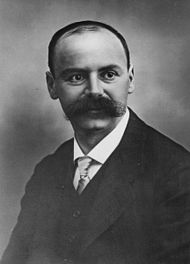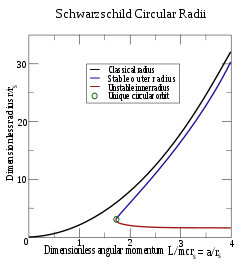Karl Schwarzschild | |
|---|---|
 | |
| Born | 9 October 1873 |
| Died | 11 May 1916 (aged 42) Potsdam, German Empire |
| Alma mater | Ludwig Maximilian University of Munich University of Strasbourg |
| Scientific career | |
| Fields | Physics Astronomy |
| Doctoral advisor | Hugo von Seeliger |
| Military career | |
| Allegiance | |
| Service/ | Imperial German Army |
| Years of service | 1914–1916 |
| Rank | Lieutenant |
| Battles/wars | World War I |
Karl Schwarzschild (German: [kaːl ˈʃvaːtsʃɪlt] ; 9 October 1873 – 11 May 1916) was a German physicist and astronomer.
Schwarzschild provided the first exact solution to the Einstein field equations of general relativity, for the limited case of a single spherical non-rotating mass, which he accomplished in 1915, the same year that Einstein first introduced general relativity. The Schwarzschild solution, which makes use of Schwarzschild coordinates and the Schwarzschild metric, leads to a derivation of the Schwarzschild radius, which is the size of the event horizon of a non-rotating black hole.
Schwarzschild accomplished this while serving in the German army during World War I. He died the following year from the autoimmune disease pemphigus, which he developed while at the Russian front.[2][3] Various forms of the disease particularly affect people of Ashkenazi Jewish origin.
Asteroid 837 Schwarzschilda is named in his honour, as is the large crater Schwarzschild, on the far side of the Moon.
Life
Karl Schwarzschild was born on 9 October 1873 in Frankfurt on Main, the eldest of six boys and one girl, to Jewish parents. His father was active in the business community of the city, and the family had ancestors in Frankfurt from the sixteenth century onwards. The family owned two fabric stores in Frankfurt. His brother Alfred became a painter. The young Schwarzschild attended a Jewish primary school until 11 years of age and then the Lessing-Gymnasium (secondary school). He received an all-encompassing education, including subjects like Latin, Ancient Greek, music and art, but developed a special interest in astronomy early on. In fact he was something of a child prodigy, having two papers on binary orbits (celestial mechanics) published before the age of sixteen.
After graduation in 1890, he attended the University of Strasbourg to study astronomy. After two years he transferred to the Ludwig Maximilian University of Munich where he obtained his doctorate in 1896 for a work on Henri Poincaré's theories.
From 1897, he worked as assistant at the Kuffner Observatory in Vienna. His work here concentrated on the photometry of star clusters and laid the foundations for a formula linking the intensity of the starlight, exposure time, and the resulting contrast on a photographic plate. An integral part of that theory is the Schwarzschild exponent (astrophotography). In 1899, he returned to Munich to complete his Habilitation.
From 1901 until 1909, he was a professor at the prestigious Göttingen Observatory within the University of Göttingen, where he had the opportunity to work with some significant figures, including David Hilbert and Hermann Minkowski. Schwarzschild became the director of the observatory. He married Else Rosenbach, a great-granddaughter of Friedrich Wöhler and daughter of a professor of surgery at Göttingen, in 1909. Later that year they moved to Potsdam, where he took up the post of director of the Astrophysical Observatory. This was then the most prestigious post available for an astronomer in Germany.



From 1912, Schwarzschild was a member of the Prussian Academy of Sciences.
At the outbreak of World War I in 1914, Schwarzschild volunteered for service in the German army despite being over 40 years old. He served on both the western and eastern fronts, specifically helping with ballistic calculations and rising to the rank of second lieutenant in the artillery.
While serving on the front in Russia in 1915, he began to suffer from pemphigus, a rare and painful autoimmune skin-disease. Nevertheless, he managed to write three outstanding papers, two on the theory of relativity and one on quantum theory. His papers on relativity produced the first exact solutions to the Einstein field equations, and a minor modification of these results gives the well-known solution that now bears his name — the Schwarzschild metric.
In March 1916, Schwarzschild left military service because of his illness and returned to Göttingen. Two months later, on May 11, 1916, his struggle with pemphigus may have led to his death at the age of 42.
He rests in his family grave at the Stadtfriedhof Göttingen.
With his wife Else he had three children:
- Agathe Thornton (1910–2006) emigrated to Great Britain in 1933. In 1946, she moved to New Zealand, where she became a classics professor at the University of Otago in Dunedin.
- Martin Schwarzschild (1912–1997) became a professor of astronomy at Princeton University.
- Alfred Schwarzschild (1914–1944) remained in Nazi Germany and was murdered during the Holocaust.
Work
Thousands of dissertations, articles, and books have since been devoted to the study of Schwarzschild's solutions to the Einstein field equations. However, although his best known work lies in the area of general relativity, his research interests were extremely broad, including work in celestial mechanics, observational stellar photometry, quantum mechanics, instrumental astronomy, stellar structure, stellar statistics, Halley's comet, and spectroscopy.
Some of his particular achievements include measurements of variable stars, using photography, and the improvement of optical systems, through the perturbative investigation of geometrical aberrations.
Physics of photography
While at Vienna in 1897, Schwarzschild developed a formula, now known as the Schwarzschild law, to calculate the optical density of photographic material. It involved an exponent now known as the Schwarzschild exponent, which is the in the formula:
(where is optical density of exposed photographic emulsion, a function of , the intensity of the source being observed, and , the exposure time, with a constant). This formula was important for enabling more accurate photographic measurements of the intensities of faint astronomical sources.
Electrodynamics
According to Wolfgang Pauli, Schwarzschild is the first to introduce the correct Lagrangian formalism of the electromagnetic field as
where are the electric and applied magnetic fields, is the vector potential and is the electric potential.
He also introduced a field free variational formulation of electrodynamics (also known as "action at distance" or "direct interparticle action") based only on the world line of particles as
where are the world lines of the particle, the (vectorial) arc element along the world line. Two points on two world lines contribute to the Lagrangian (are coupled) only if they are a zero Minkowskian distance (connected by a light ray), hence the term . The idea was further developed by Hugo Tetrode and Adriaan Fokker in the 1920s and John Archibald Wheeler and Richard Feynman in the 1940s and constitutes an alternative but equivalent formulation of electrodynamics.
Relativity

Einstein himself was pleasantly surprised to learn that the field equations admitted exact solutions, because of their prima facie complexity, and because he himself had produced only an approximate solution. Einstein's approximate solution was given in his famous 1915 article on the advance of the perihelion of Mercury. There, Einstein used rectangular coordinates to approximate the gravitational field around a spherically symmetric, non-rotating, non-charged mass. Schwarzschild, in contrast, chose a more elegant "polar-like" coordinate system and was able to produce an exact solution which he first set down in a letter to Einstein of 22 December 1915, written while he was serving in the war stationed on the Russian front. He concluded the letter by writing: "As you see, the war is kindly disposed toward me, allowing me, despite fierce gunfire at a decidedly terrestrial distance, to take this walk into this your land of ideas." In 1916, Einstein wrote to Schwarzschild on this result:
I have read your paper with the utmost interest. I had not expected that one could formulate the exact solution of the problem in such a simple way. I liked very much your mathematical treatment of the subject. Next Thursday I shall present the work to the Academy with a few words of explanation.

Schwarzschild's second paper, which gives what is now known as the "Inner Schwarzschild solution" (in German: "innere Schwarzschild-Lösung"), is valid within a sphere of homogeneous and isotropic distributed molecules within a shell of radius r=R. It is applicable to solids; incompressible fluids; the sun and stars viewed as a quasi-isotropic heated gas; and any homogeneous and isotropic distributed gas.
Schwarzschild's first (spherically symmetric) solution does not contain a coordinate singularity on a surface that is now named after him. In his coordinates, this singularity lies on the sphere of points at a particular radius, called the Schwarzschild radius:
where G is the gravitational constant, M is the mass of the central body, and c is the speed of light in vacuum. In cases where the radius of the central body is less than the Schwarzschild radius, represents the radius within which all massive bodies, and even photons, must inevitably fall into the central body (ignoring quantum tunnelling effects near the boundary). When the mass density of this central body exceeds a particular limit, it triggers a gravitational collapse which, if it occurs with spherical symmetry, produces what is known as a Schwarzschild black hole. This occurs, for example, when the mass of a neutron star exceeds the Tolman–Oppenheimer–Volkoff limit (about three solar masses).















